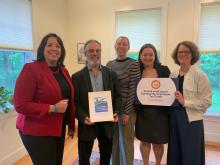“Where are you here from?” I asked the person behind me in the registration line at the National Rural Health Association’s Annual Conference, in Albuquerque, New Mexico.
“Montana,” he answered, “how about you?”
“Boston,” I said, and, noticing his confused look, I added, “I work in all of Massachusetts – we have a lot of rural areas.” After that initial conversation, I started answering “Massachusetts” to that ubiquitous question.
While I live and work in Boston, MACDC works with CDCs in communities throughout the Commonwealth, and about 17% of our members work in rural areas of Massachusetts. In fact, according to the Census Bureau, well over half of Massachusetts’ land mass is considered rural. However, my instinct to say I’m from “Boston” reveals more than the zip code where I live. My instinct indicates my association with this urban area of the state, despite my efforts to represent the breadth of urban, rural, and suburban communities in Massachusetts.
Fortunately, my attendance at the National Rural Health Association’s conference gave me the opportunity to immerse myself in the diverse experiences of residents of rural America. The following were a few themes that stuck out to me:
The Importance of Telehealth – Telehealth is a familiar concept to many of us, being well into the third year of the COVID-19 pandemic, in which many health services were delegated to the virtual realm. In my experience, a telehealth option can be more convenient than traveling to see a clinician in-person and is of course safer in the context of a highly contagious disease. At the National Rural Health Association conference, I learned how clinicians in Minnesota deliver specialized emergency care to remote areas of the state in situations where it would be impossible to deliver in-person care in time to save someone’s life. In this model, specialists connect with less specialized physicians in smaller, local hospitals to collaboratively diagnose and treat patients undergoing cardiovascular events. Learning about this use of telehealth broadened my understanding of the ways in which this technique can be used.
The Unique Mental Health Concerns – Mental health care is crucial in all geographies and takes on added challenges in rural areas. One presenter described how stigma around mental health takes on added meaning in a rural area where everyone knows each other: “People in my town know when I go to get my haircut, they will know if I am seeing a therapist!” In addition to stigma, the challenge of having enough practitioners for the residents who need care is significant in many rural areas of the country. The lack of sufficient mental health support can be particularly challenging in smaller populations where, in many cases, it can be confounded by lack of peer support, such as in the case of LGBT youth.
Challenges and Innovations in Clinician Recruitment – One challenge which I am familiar with intellectually, but which my life in Boston is often divorced from, is the challenge of recruiting physicians and other clinicians to rural areas of the country. A high patient-to-physician ratio leads to physician burnout and less physician availability. I learned about several creative solutions to this challenge. One is an effort to recruit new doctors who have not matched for clinical residencies to spend time in rural areas before re-entering the matching process. Another innovative program around the corner from my Boston office: At Massachusetts General Hospital (MGH) a number of physicians participate in 3-month rotations treating patients on a reservation in South Dakota.
Both before and during the conference, I also had the opportunity to think about how, in addition to direct medical care, social determinants of health, and in particular, community and economic development, uniquely impact rural health, and how CDCs are stepping up to meet these challenges. For example, in areas where there isn’t a tax-base for public transportation infrastructure, residents rely on services such as the Quaboag Connector, which the Quaboag Valley CDC runs in collaboration with the Ware Council on Aging and other local social service agencies. The impacts of housing type and quality on health is unique in an area like the Hilltowns of Western Massachusetts, where single-family homes predominate, creating a dearth of accessible housing for seniors and people with disabilities. Hilltown CDC addresses this issue through building and renovating homes for seniors, and through the Hilltown Elder Network, which pays local people to provide in-home chore services and transportation for low-income elders. Lower wages in rural communities mean less income available for health-supporting goods and services, like healthy foods and medication. The CDC of South Berkshire assists in mitigating this issue by providing support for small businesses. I appreciated the opportunity to connect these themes of the conference with the work in which our rural members are engaged in.
In addition to learning about these specific issues, I appreciated the opportunity to absorb myself in thinking about the unique challenges and opportunities connected with living and working in areas of the country that are less dense than the urban area with which I’m familiar. The conference highlighted the importance of creating and taking advantage of opportunities to better understand landscapes and experiences that are not a part of my everyday life – to truly “work in all of Massachusetts.”









